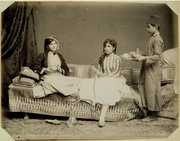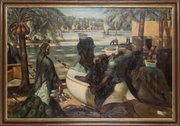
Pearl Drop Pendant
Museum of Islamic Art
- Title:
- Pearl Drop Pendant
- Production place:
- India
- Date:
- 1574 - 1575
- Period:
- Mughal
- Title:
- Pearl Drop Pendant
- Production place:
- India
- Date:
- 1574 - 1575
- Period:
- Mughal
- Material:
- Pearl, Gold, Enamel, Silver, Solder
- Technique:
- Enamelling, Mounting, Cutting, Soldering
- Dimensions:
- 4 × 1.8 cm
- Diameter:
- 1.8 cm
Pearls are ubiquitous in Mughal jewellery, but always as round, uniformly shaped beads. This massive baroque pearl must have been prized for its size and perfectly imperfect shape. It was drilled for suspension as a pendant, perhaps from a necklace, and given a decorative gold setting in the form of petals that were originally enamelled. Marks in the gold cap of the pearl have been read as the number 982, and interpreted as representing a year, corresponding to 1574-75 CE, which falls during the reign of the Mughal emperor Akbar (r. 963-1013 AH/1556-1605 CE). Whether or not the pearl can be securely connected with this particular monarch, pearls do indeed figure as one of the five highest value stones in Akbar’s treasury, in which they were classified just after rubies, diamonds, emeralds and sapphires, and where they were stored, mounted on strings, according to size. Although pearls could also be found in the Gulf of Mannar (between India and Sri Lanka), the largest pearls in the pre-modern era came from the Arabian Gulf, which was likely the source for this object.



